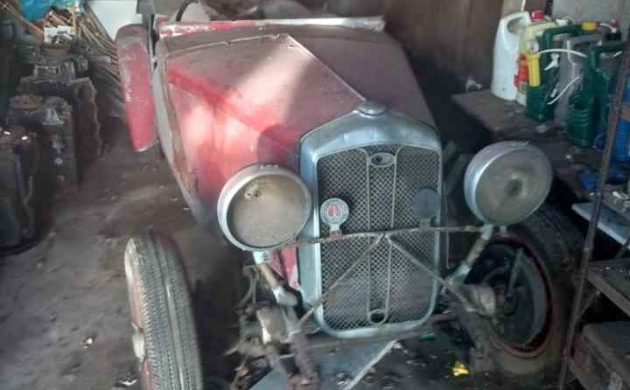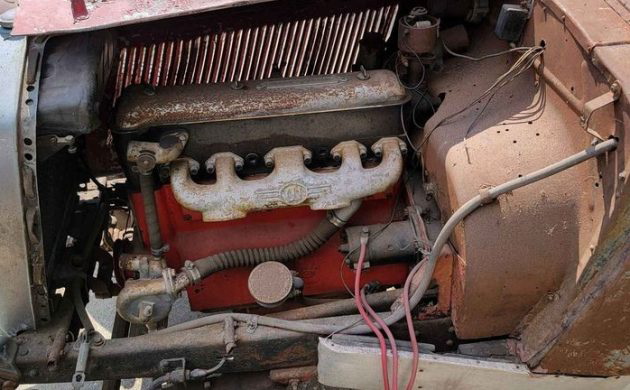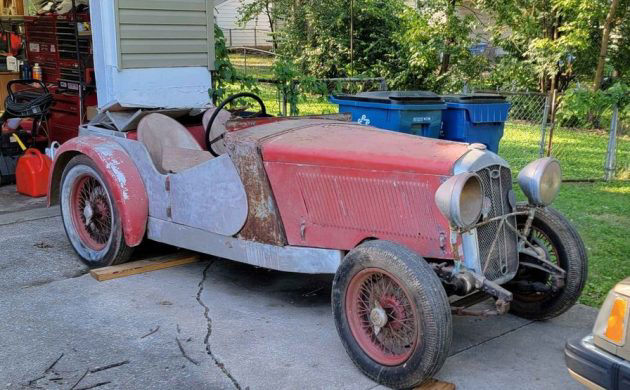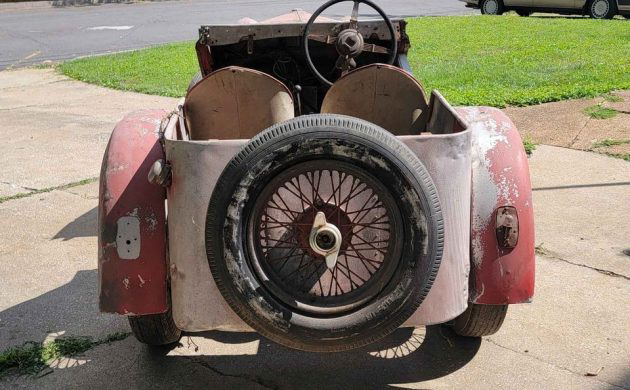Here’s an obscure one for you, a 1934 Wolseley Hornet Special. Manufactured by Wolseley Motors Limited, a Birmingham, England manufacturer. This right-hand drive, and now in two-seater form, has been languishing, hidden away in St. Louis for many years. It has undergone some modifications, is missing some parts, and doesn’t currently run – definitely a project! But then again, how often are you likely to encounter one? Interested parties can find this curious little car here on Facebook Marketplace where it’s available for $5,000. Thanks are due to NW Iowa Kevin for this tip!
So yes, this Hornet looks like a two-seater but the seller states, “It had an Eustace Watkins Ltd Body fitted originally. This car would have been the E.W. International Full 4-seat body, based on the cowl area“. I suppose that explains why the not-so-hot-looking “Dunlop pneumatic seats” look like there’s almost in the back seat. The interior is rather gutted though there is one image on an instrument panel so I guess it’s included, just not attached. Missing parts, among others, would include the passenger side door, bumpers, front fenders, one of the taillights, and the windshield though the seller does mention that he has the door.
The engine appears to be a 48 HP, 1,600 CC in-line six-cylinder unit that turns over but does not start or run. Some of the problem is due to the, “missing the generator, carbs, and the cap for the oil sump“. The gearbox is a four-speed manual arrangement, standard for the Special, as opposed to the regular Hornet’s three-speed manual transmission.
Originally based on a Morris Minor saloon, four different coach builders offered Hornet bodies. The styles varied as the Hornet was offered in two and four-door body styles, saloons, and open cars as well. As previously noted, some two-door examples were built to accommodate either two or four passengers. I’m not sure what to make of the body. It has a bit of surface rust but doesn’t appear to be rotted – it’s just disorganized looking. Not knowing these cars well makes identifying missing components more difficult. Also mentioned is the removal of this Hornet’s rear section and it undergoing a change but there’s no elaboration beyond that – it’s a bit homemade looking. My thought is that there should be a folding top or a tonneau cover at the least and images of intact examples show running boards – the lack thereof, contributing to this car’s very unfinished appearance. The seller mentions that this Hornet is riding on an X-frame, specific to the Special, so that helps to further identify this model. Any way you measure it, these are small cars with a 95″ wheelbase, 141″ length, and 2,100 lb. curb weight – a genuine two-seater is even more constrained.
The Hornet was produced between 1930 and 1936 – total output reached about 6K copies. And while 6K is a small number, the question would be how many are left? Also, what is the parts availability like? This is a neat, scarcely encountered car but I would suggest that potential buyers do their homework and learn as much about the Wolseley Hornet as they can – it’s hardly a run-of-the-mill find, right?







Its the Chitty Chitty Bang Bang car!
Talk about finding parts!! That alone makes this one a real challenge! Good looking old vehicle but I think I shall pass!
Then again…. make it a fun reliable driver and drop a Toyota 4 cyl 22R motor with a 5 speed! People will love seeing it driven around no matter how ‘unoriginal’ it is!
Get a kit car if that’s what you want to do these cars are rare enough without turning the survivors into retro mods.
Though obscure to us now, partially because they are pre-war cars but partially because Wolsleys did not come to the US, these cars were in the vanguard of pre-war Brits. Lightweight but equipped with a six-cylinder engine, the cars were raced with modest success. Top speed was about 75 mph. The Special was only sold as a chassis with drivetrain; the cars were bodied by Swallow, March, Avon, Cunard, and others. Eustace Watkins bodied this car; he was the largest Wolsley dealer in the UK at one point, and also a coachbuilder – an unusual combination for sure. It would not have been unusual for a body to be altered or changed entirely in the day; the same phenomenon applied to Bentleys.
Anyway, this is a really neat car, and parts can be had with enough perseverance. Were I not heavily involved with a Berkeley, I would negotiate on this one.
These are quite popular within the VSCC so there is club support in the UK.
If anyone in the US wants to do something with this car they will have to get their support from the UK.
Agree with you that price should be negotiable. Hard to find a new home for this!
The car in question could be retrofitted with a set of Blakley Bernardi front fenders if you can find someone who will let you make a mold off of their car. There is a company in Flippin Arkansas ( Spirit Industry) that may be able to make those fenders.I personally would take a Ford 2.3 turbo or non turbo( your choice) and install a 4 speed manual transmission
There are resources out there, but this one is bit too much work for me to take on.
Check this site: https://www.wolseleyregister.co.uk/wolseley-history/pre-war/hornet-hornet-special/
And when you got it finished you’d probably hear “Neat old MG”
Both were Nuffield brands. The MG sohc engine derived from Wolsely I think.
They were also built with a parallite body. It’s worth looking this up!
An old boss of mine had a Wolsey Hornet he had restored. Fantastic little thing. Great fun, and his was immaculate. It’s almost tempting to send this back to England (freight prices are at their lowest ebb) and see if he can sell it through the Hornet Register.
Forgot all about Wolseley. I think they must have been sold in Canada in the late Fifties to mid ‘60’s as we had one on our street. A sedan style vehicle, much in the vein of a Rover.
I had an MG SA (1939) that originally used the same engine, MG sourced it from Wolseley. The MG records indicated that only 500 were so fitted before WWII began and production stopped. Serviceman brought it over after the war, engine was supposedly “rare”, as were parts, installed a Hudson Super 6, much heavier and longer, requiring cutting into the firewall and the radiator could not keep up with the heat. I was about to install a MOPAR slant six which would have fit better, but life intervened, house, mortgage, 3 kids, sold it. Now, fifty years later, with the internet, there were thousands of these engines, the standard UK police car was a Wolseley with this engine, and parts are available, albeit used. So rebuilding the engine, if required, is not impossible.
In BMC days it was a British class thing. The Pininfarina mid-sized range ranked ( low to high).
Austin Cambridge
Morris Oxford
Wolsely 16/60
MG Magnette
Riley 4/68
Then we lost the Empire….
Those are BMC cars and nothing like the pre 1953 Wolseley’s. The early 50s 6-80 Wolseley had a 2200cc motor. This car at 1600ccs is a bit larger than the 1934 MG K3 and KN cars. The 6-80 Wolseley motor bolts up to a MG TC OR TD 4 speed.
A previous owner/restorer may have intended to turn it into a vintage-race car, which even now would be the simplest way to restore it.
Agreed; this would be a good starting point for a vintage racer. The existing body is very square; put a 2-seater boat-tail on it and go and have some fun!
Alloy motorbike mudguards for water deflection. It rains on racetracks too…
It should done as a Wolseley Hornet Special. There are not that many left. If I were younger I would buy it. I built a MG Special that looks about like a PA/B racer and made templates of real prewar MG bodies. If you want to do it with a modern motor and 5 speed, build a Model T Ford speedster.
One other thought about restoring it would be to use 1951 Singer 1500 wings and running boards. They are not that hard to find in the US.
My “daily” driver is a Wolseley 6/99 I also have a parts 6/110. Quite the “modern” British vehicles. I believe it came through Canada, although it has no previous paperwork. High quality manufacturing and durable.